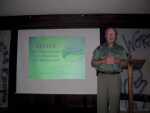KU grad students offer help with riverfront project

By Michael Glover
Herald-Tribune
Fort Scott, Kan. -- A group of graduate students from the University of Kansas offered suggestions on Friday to a committee that has initiated a plan to build a riverfront project on the Marmaton River.
Since February, 10 students from KU's Urban Planning Environmental graduate class have studied a plan devised by the Develop The River As An Asset committee.
For more than a year, the committee has been working on the project. Dean Mann, co-convenor for the committee, first proposed the idea to the public in February 2006.
The project aims to turn the Marmaton River and surrounding areas between U.S. Highway 69 and National Avenue -- possibly even further west and south to Gunn Park -- into a flourishing wildlife and recreational park. Components will include a lake, picnic and fishing areas, miles of trail, a pedestrian bridge, a botanical garden, a campground, wildlife viewing areas, and historical panels reflecting the history of the area. It will include equestrian, hiking and biking trails that will run along the river east to 240th St., past U.S. 69.
In the weeks following a visit to the river in February, the students identified research areas they wanted to study. There were 10 students in the graduate class, so each student chose to study a single area.
The 10 areas were clean-up, weir (small dam) proposal, bank stabilization, land access, trails, campground area, lake area, botanic garden, maintenance and funding. The study areas were plucked from a conceptual design created by the committee.
Christy Lake, one of the students who presented the study, discussed each of the areas.
She said the Marmaton River has steep grades down to the river, mainly because of erosion. "That's not normal for a healthy river," Lake said.
The banks should be stabilized, she said. That can be achieved by concepts called "soft or hard" engineering.
Hard engineering means using concrete and rip-rap rock to level up the shore. It's not environmentally friendly.
Soft engineering uses vegetation to naturally stabilize the banks. Many times, using soft engineering can be cheaper and more aesthetically pleasing. The students recommend soft engineering.
The study suggested the project not include a campground area. Lake said there are access concerns to the site for bigger recreational vehicles. Also, soil testing in the area is not conducive to support the larger vehicles.
Lake recommended a dog park, public gathering area, or a native demonstration garden could be built instead of the campground.
The students did give the go ahead to build a 15-acre lake. They suggested the committee get a site survey for the land to determine what type of lake should be constructed.
All of the research areas will require two important criteria: maintenance and funding.
Lake said maintenance is important for the project "to survive," which can be accomplished through volunteers.
"We believe volunteers are the key to this," Lake said. "They are the ones who have to make it work."
At some point in the process, project leaders have to look at securing federal grants for funding. Lake said the key is learning about the grants. She advised they look into using the Internet and getting a grant writer.
They set up three goals for their study: to protect and restore the environmental integrity of the riverfront, educate residents on the cultural and natural history of the area and provide multiple outdoor recreation opportunities related to the river.
"You have to really get people to become educated and interested in the project," graduate student Wes Sterneergner said. To accomplish that, the emphasis should be on history of the area. In fact, panels explaining key historical facts about the area have been included conceptual design.
Another goal is to provide multiple outdoor recreation opportunities related to the river.
"You don't want it just to be a place where people will go and walk," he said. "You want to be a place where they can walk, bike, fish, boat and maybe swim. You want this project to be a place for people. We're not trying to create a wilderness area."
The study recommended that the project be specifically tailored to Fort Scott. He said you can't copy another city's riverwalk project. It must fit with Fort Scott.
Sterneergner concluded the presentation by discussing three overall recommendations to the committee.
* Priorities for different aspects need to be set.
"You really need to have a clear idea of what you want to have happen first," he said.
* A timeline needs to be devised. The project can be phased in one area at a time to show the community the project is for real. Most of the successful riverwalks in cities have used the phased-in approach.
"Small victories in the beginning can help convert skeptics to be on your side," Sterneergner said.
* The final recommendation urged the committee to include the project in the City of Fort Scott's comprehensive plan, which is currently being updated.
"Yes, today we have shown you the limitations of your plan," he said. "I'd like to think we've also shown you the possibly your plan holds."
Mann said the study has hit on many of the topics the committee has been discussing.
"The good part of this is that you've given us a framework that we can go ahead and develop," Mann said.
The students will be sending the committee a final report on their study in the next couple of weeks. Mann said the group will use it to further enhance the plan.
